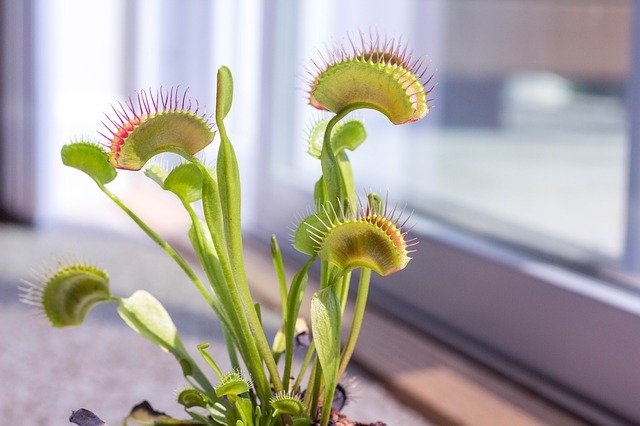Venus flytrap plant is fun to grow and fascinating to watch and learn about. This is a moisture loving plant that grows near marshes and bogs. The plants have been overharvested in their native habitat and are becoming rare.
Native to only a few areas in North and South Carolina, Venus flytraps grow in nitrogen depleted soils. This is why they trap insects, which provide them with the necessary nitrogen. Venus flytrap care is relatively easy and makes a great family project.
How to care for Venus flytrap
The Venus flytrap needs slightly acidic moist soils. Grow a Venus flytrap in a peat moss and sand mixture, which will provide mild acidity and help hold water without keeping soils too soggy.
The plant needs at least 60 percent humidity and day time temperatures of 70 to 75 F. (22-24 C.). Nighttime temperatures should not go below 55 F. (13 C.). The Venus flytrap is sensitive to chemicals and heavy mineral contents, so a distilled or bottled water is best. Keep water off the foliage by soaking the plant for an hour in a dish of water to moisten the soil.
In order to make Venus flytrap care easier, make it a terrarium. An old aquarium makes a good housing for the plant if you cover it. This encourages humidity and moisture retention and you can allow insects to fly around inside for the plant to catch. Line the inside with two parts sphagnum moss and one part sand. The Venus flytrap can then be placed in an east- or west-facing window with high indirect lighting.
Venus flytrap is a rosette form with four to six leaves that are hinged and able to close. They are tinged a rosy pink on the edges and secrete an attractive nectar. The edges of the leaves have numerous fine sensitive cilia. When an insect touches the cilia the leaf closes and traps the insect. Special digestive juices disintegrate the insect and the plant feeds on the insects bodily fluid. Caring for a Venus flytrap must ensure that it is exposed to areas where it can capture insects. Learn how to care for a Venus flytrap to help this disappearing species continue.
What to feed Venus flytrap
The flytrap lives up to its name by using its clasping leaves to trap insects. Its diet is not only confined to flies and it will eat creeping insects such as ants, too. When you are caring for a Venus flytrap indoors, you need to assist them by capturing insects. Use tweezers and place the insect on an open leaf pad and tickle the little hairs on the edge until it closes. Some people try to water with beef bouillon or another protein but this can cause mold to form and is not recommended.
Care during dormancy
Venus flytraps bloom in the spring, grow through the summer and fall, and go dormant through the winter (roughly 3-5 months). They do not die in the winter, although it may look like they are. They just aren’t trying as hard to grow in order to conserve energy for the next growing season.
This doesn’t mean you can just neglect them. They still need sunlight and water to perform photosynthesis. Here are some tips to help your plant make it through the winter:
- The best place to keep them is outdoors, but make sure you don’t live in a region that is susceptible to frosting and freezing. Plants in pots are more likely to freeze over, so the best tip is to move them into the ground, where the soil large volume of soil can act as insulation that protects the rhizomes. Remember to use acidic, sandy soil that is suitable for Venus flytraps.
- Keep the plants cool, but don’t allow it to freeze. The ideal temperature range during dormancy is between 32 ºF and 55 ºF (0 ºC-11 ºC). However, it will still stay dormant at higher temperatures.
- Some people keep their flytraps in a plastic bag in the fridge for the entire winter. If you choose to do this, remove dead leaves (appear brown or black) and mist with fungicide to prevent mold and fungal growth. Check on them periodically to make sure they have enough water
- Give them some sun, but less sun than usual. Dormancy is thought to be brought on by a combination of dropping temperatures and shorter days (shorter amount of daylight). During the winter, the plants should receive less than 12 hours of light.
- Keep the soil damp, but you don’t have to water as much. The plant still needs some water, but it won’t be using up as much of it. Monitor the moisture of the moss daily for the first week to help you gauge how often you need to water.
When it comes out of dormancy, gradually increase the amount of sunlight, food, and water.
Source:

